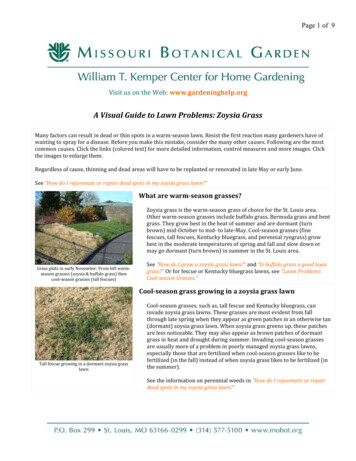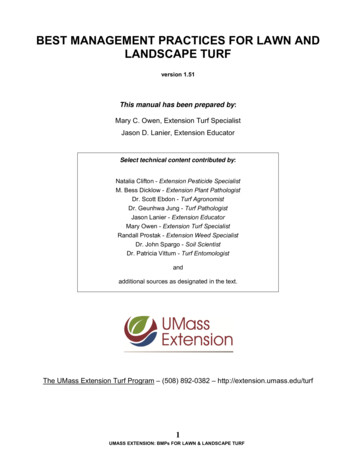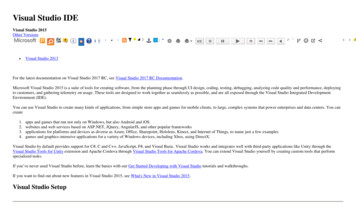
Transcription
Page 1 of 9Visit us on the Web: www.gardeninghelp.orgA Visual Guide to Lawn Problems: Zoysia GrassMany factors can result in dead or thin spots in a warm-season lawn. Resist the first reaction many gardeners have ofwanting to spray for a disease. Before you make this mistake, consider the many other causes. Following are the mostcommon causes. Click the links (colored text) for more detailed information, control measures and more images. Clickthe images to enlarge them.Regardless of cause, thinning and dead areas will have to be replanted or renovated in late May or early June.See “How do I rejuvenate or repair dead spots in my zoysia grass lawn?”What are warm-season grasses?Zoysia grass is the warm-season grass of choice for the St. Louis area.Other warm-season grasses include buffalo grass, Bermuda grass and bentgrass. They grow best in the heat of summer and are dormant (turnbrown) mid-October to mid- to late-May. Cool-season grasses (finefescues, tall fescues, Kentucky bluegrass, and perennial ryegrass) growbest in the moderate temperatures of spring and fall and slow down ormay go dormant (turn brown) in summer in the St. Louis area.Grass plots in early November: From left warmseason grasses (zoysia & buffalo grass) thencool-season grasses (tall fescues)See “How do I grow a zoysia grass lawn?” and “Is buffalo grass a good lawngrass?” Or for fescue or Kentucky bluegrass lawns, see “Lawn Problems:Cool-season Grasses.”Cool-season grass growing in a zoysia grass lawnTall fescue growing in a dormant zoysia grasslawnCool-season grasses, such as, tall fescue and Kentucky bluegrass, caninvade zoysia grass lawns. These grasses are most evident from fallthrough late spring when they appear as green patches in an otherwise tan(dormant) zoysia grass lawn. When zoysia grass greens up, these patchesare less noticeable. They may also appear as brown patches of dormantgrass in heat and drought during summer. Invading cool-season grassesare usually more of a problem in poorly managed zoysia grass lawns,especially those that are fertilized when cool-season grasses like to befertilized (in the fall) instead of when zoysia grass likes to be fertilized (inthe summer).See the information on perennial weeds in “How do I rejuvenate or repairdead spots in my zoysia grass lawn?”
Page 2 of 9Heat and drought stressAlthough zoysia grass is more tolerant of heat and drought than any of thecool-season grasses, in severe heat and drought it may go dormant or die.Dormant lawns green-up when environmental conditions improve.Irrigated lawns are less apt to go dormant but run the increased risk ofdisease and insect problems. Zoysia grass requires about ½ inch of waterper week to remain green and about ¼ inch of water per week to stay alivein dormancy.Patches of zoysia grass dying due to heat anddrought stressSee “Drought and Water Stress” and “When and how should I water myzoysia grass lawn?”Is it dead or just dormant?Dormant zoysia grassIn the St. Louis area zoysia grass turns tan or brown in the fall and doesnot green up until spring (usually late May). Although it is heat anddrought tolerant, it can go dormant or die during extreme heat or drought,especially when the two are combined. Determining if a patch of grass isdead or just dormant can be difficult. A close examination is required.Dormant grass will be firm at the base and resist a gentle tug. Dead grasswill be shriveled with dead roots. It can be uprooted easily and will havedead, non-functioning roots. Dormant grass can resume growth; dead willnot.Dry slopesSunny, south or west-facing slopes are difficult locations for all grasses.These sites are also difficult to irrigate. Long, slow watering is needed tofacilitate water uptake and prevent runoff. More frequent watering isneeded in the heat of summer.Slopes, especially those near sidewalks anddriveways can be difficult areas to water.Shade and tree competitionNo lawn grass will thrive in dense shadeZoysia grass will only tolerate lightly shaded areas. It is virtuallyimpossible to grow it, or any other lawn grass, in a heavily shaded area.Grass growing in shade under or close to trees can experience tremendouscompetition for ample light and moisture. It will be thin and never as lushand green as grass growing in full sun. Some grasses, such as the finefescues (red, hard, sheep, spreading, creeping and chewing), are moretolerant of shade, but may still be unable to compete against tough, shadeloving weeds, such as, violets and nimblewill, especially in deep shade.Watering can help the dry situation but wet conditions can result inincreased disease problems, such as, necrotic ring spot or pythium blight.See “What lawn grasses will grow in the shade?”
Page 3 of 9CompactionGrass will not grow well in soil that has been compacted by vehicles or foottraffic. Small areas can be dug with a spading fork or rototilled to a depthof 8-10 inches to loosen the soil. Large areas of zoysia grass or the entirelawn can be core aerified in late May or early June to help alleviatecompaction and then plugged or sodded at the proper time (late May toearly June in the St. Louis area).See "What is core aerification and when should I do it?"Note tire trackFungal DiseasesZoysia grass is susceptible to a number of fungal diseases. The mostcommon is large brown patch, which begins as small circular patches ofbrown, lifeless grass that can enlarge and join together. Most fungaldiseases exhibit distinctive patterns in the lawn or spots (lesions) on theleaf blades that aid in their identification. A very close examination ofdying (not dead!) leaf blades is needed to verify which, if any, disease ispresent.Large patch image from “Issues with ZoysiagrassLawns,” Missouri Environment and Garden, (April30, 2012)Diseases occur when very specific environmental conditions oftemperature and moisture are present. Many diseases run their coursebefore a homeowner can act, making the application of a fungicide of littleor no value. Changes in environmental conditions or managementpractices can also halt a disease.Lookalikes: Drought, chinch bugs, hunting billbugs, and nearly all theproblems listed in this guideSee “What leaf diseases affect lawns in this area?” and “Fungal Diseases ofLawns” and “Large Brown Patch of Zoysia Lawns.”InsectsFeeding activity of certain insects, such as, grubs (see below), can causedead areas in lawns. Holes or scratched or torn areas of turf can be theresult of birds and other animals scavenging for insects in the soil. Mostproblem insects are large enough to be seen and identified with a close,proper, and thorough examination. Get down on your hands and kneesand look closely, keeping in mind that healthy soils contain manyharmless or beneficial insects that should not be killed.Ants aerate the soil and break down organicmatter.Cicada on the right; cicada killer wasp on the left.As soil-dwelling insects, both are harmless.See “How do I check for insects in my lawn?” and “What insects areproblems with zoysia grass lawns in this area?” and “Insects”
Page 4 of 9Chinch bugs“Issues with Zoysiagrass Lawns,” MissouriEnvironment and Garden, (April 30, 2012)Chinch bugs (Blissus spp.) are the most damaging insect pest in zoysiagrass. Unlike large patch, chinch bug damage occurs in the hot, drysummer months and most closely resembles drought damage. Affectedareas are solid, not patchy, and will usually start on one side of the lawnand progress throughout as the chinch bug population builds and moves.Damage is most severe along lawn boundaries, particularly concretedriveways and sidewalks. The easiest method to detect chinch bug damageis to pull up damaged zoysia grass along these boundaries and look for thescattering, fast-moving, small (3/16-inch) black bugs. If chinch bugs arepresent, there is no recourse but the use of a curative insecticide toeliminate the problem. Because occurrence is sporadic from year to year,preventive insecticide applications targeted for chinch bugs are notrecommended in this area.Lookalikes: Drought, grubs (see below), hunting billbugs (see below)See “How do I check for insects in my lawn?” and “Chinch bugs.”A. Cushman, USDA; Property of theSmithsonian Institution, Dept. ofEntomology, Bugwood.orgHunting billbugsUnlike chinch bugs, hunting billbugs are more elusive. Adults are reddishbrown-black, ½-inch long, have a curved snout, and are most active duringthe night and early morning hours. Billbugs are thought to overwinter asadults, and lay eggs in grass stems/leaf sheaths in mid-late spring. Billbuglarvae, which unlike annual white grubs are legless, hatch and feed byboring into lower leaf stems. Larvae feed on stolons, which are leftcharacteristically hollowed out in early summer. At this point, zoysia grasswill easily pull away from the soil, and symptoms will occur as yellowareas that eventually brown and die out, resembling drought damage.Lookalikes: Drought, grub damage (see below), chinch bugs (see above)See “Hunting Billbugs – Emerging Problem for Zoysiagrass in Missouri,”(from Missouri Environment and Garden, July 2, 2102), and “How do I checkfor insects in my lawn?” and “What insects are problems with zoysia grasslawns in this area?”Images from “Issues with Zoysiagrass Lawns,”Missouri Environment and Garden,(April 30, 2012)
Page 5 of 9GrubsGrubs are the immature form of beetles. They can be a significant problemin irrigated lawns if their population is high. Symptoms of grub problemsare gradual thinning and weakening of the lawn followed by small patchesof dead or wilting grass even in the presence of adequate soil moisture.Kentucky bluegrass is especially susceptible. Damage is often most evidentin August and September. When severe, you can tug at the lawn and easilypull it up like pulling up a piece of carpet. Treatment is advised if 10 ormore grubs are found per square foot.See “Grubs in Lawn,” and “What insects are problems with zoysia grasslawns in this area?”Grass peeled off to reveal grubsImproper wateringImproper watering may result in many problems for a zoysia grass lawn.Zoysia grass is intolerant of standing water and may die out in low areaswhere water can collect. Although root rots may be obvious, many otherproblems may not be as obvious. Shallow rooting, increased susceptibilityto disease, and attractiveness to grubs are a few of the other problemsimproper watering can cause.Zoysia grass killed by watercollecting in low areas during awet summerSee “When and how should I water my zoysia grass lawn?Improper fertilizationCareless fertilizing can result in brown spots or streaks. Over applicationof nitrogen in spring results in excessive top growth and poor rootdevelopment. It can also result in lush top growth that is more susceptibleto disease, insects and summer drought. In general, slow release fertilizersare best. Fertilize only when grass is actively growing (late May throughAugust in the St. Louis area).See “When and how do I fertilize my zoysia grass lawn?Too much fertilizer applied too early can reduceroot growth and drought tolerance
Page 6 of 9Nutrient deficienciesMost homeowners want a lush green lawn, butthis is only possible with proper care andnutritionGrasses need both macronutrients and micronutrients. Macronutrients arenitrogen, phosphorus, potassium, calcium, magnesium and sulfur. Thereare many micronutrients, including iron. Nitrogen is required in thegreatest amounts and is present in all lawn fertilizers and may be the onlynutrient that needs to be applied. In the St. Louis area, soils usually containsufficient quantities of all macronutrients (except nitrogen and sometimespotassium) and usually contain all micronutrients, except iron. Adeficiency is more likely if grass clippings are routinely bagged orremoved. Only a complete soil test can determine if a nutrient deficiencyexists.A basic soil test will measure the soil pH which should be 6.0 to 6.8 forhealthy growth. When the soil pH is out of this range the grass will beyellowish green. A basic soil test also measures the percentage of organicmatter in the soil, which ideally should be from 5% to 20%. Soils in thisarea are usually deficient in organic matter. Using organic fertilizers willhelp remedy this.See “Nutrient deficiencies,” and “How do I test my soil?” and “Soil testing andsample collection,” and “When and how do I fertilize my zoysia grass lawn?”LimingYellowing of grass blades could indicate a soil pHthat is too high (or occasionally too low)Lawns in the St. Louis area should never be limed unless a soil testindicates that the pH is below 6.0. Lime increases the pH of the soil,making it sweeter or more alkaline. The pH of most soils in the St. Louisarea hovers around neutral (7.0) or above, because the soil sits onlimestone bedrock and is rich in naturally occurring lime. If more is addedunnecessarily, the soil can become too sweet (alkaline) to grow grass andmany other plants, including many trees, because plants cannot take upnutrients if the pH is out of range. A pH between 6.0 and 6.5 (slightly acid)is a good compromise for most plants grown in this area.See “How do I lime my lawn?”Improper mowingImproper mowing can take many forms from a dull mower blade toscalping. A dull mower blade can give your grass a tan or brownishappearance from the dead, frayed grass blades. Scalping (cutting the grasstoo short) makes the lawn look brown by removing too much leaf surfaceand increasing the soil temperate by exposing it to more direct sun.Increased heat and drying can force the grass into dormancy or kill itoutright.A dull mower blade can result in torn or raggededges on blades of grass.See “How often and how high should I mow my zoysia grass lawn?”
Page 7 of 9Grass clippingsGrass clippings are not thatch and will not add to the thatch layer. Ifpossible use a mulching mower and leave the grass clippings todecompose. Doing so will substantially reduce the amount of fertilizerneeded for a healthy lawn. Bag or remove clippings only when clippingspile up and mat.Pile of grass clippings that will kill thegrass underneath unless removedSee “Should I collect my grass clippings?” and “What is lawn thatch and howdo I check for it?”ThatchThatch is a layer of living and dead grass crowns, roots, lower shoots andother organic debris at the soil surface. It appears as a layer of brown,tightly compressed, peat moss-like material. It is not the result of leavinggrass clippings on a lawn. It is often a problem in zoysia grass lawns,especially in over-fertilized lawns. A layer thicker than ½ inch can inviteinsect and disease problems.University of Missouri Extension Guide G6708“Thatch–Enemy of Lawns”See “What is lawn thatch and how do I check for it?”Mushrooms in the lawnMushrooms are common occurrences during rainy weather. They live offdecaying organic matter in the soil, often decaying tree roots, and are notharmful to the lawn. They will disappear as they age, can be collected andcomposted, knocked down with a rake or hoe, or mowed over with yourlawnmower. Never collect and eat unless you are an expert in theiridentification.Holes or torn up turf in the lawnSmall holes in the lawn can have a number of causes: birds foraging forinsects, cicadas emerging from underground, earthworms surfacing, andother harmless insects emerging from the soil. Treatment is generallyunwarranted unless a close, proper, and thorough examination revealshigh numbers of grubs (discussed above).Hole in lawn possibly caused by foragingbirdsLarger holes may be caused by animals, such as, moles, voles, gophers, orrabbits. Torn or scratched up turf usually indicates that an animal hasbeen foraging for insects. Skunks are often the culprits, but other animalsmay also be to blame, such as, raccoons, squirrels, armadillos, or rabbits. Athorough search for grubs (discussed above) is indicated, but the grubsmay no longer be present due to the foraging animal.See “Animals”Torn up lawn possibly caused by aforaging animal, such as, a skunk
Page 8 of 9Earthworm castingsAs earthworms move through the soil they often leave small piles orcastings in the lawn. The castings and earthworms are harmless andactually beneficial for the soil as they help aerate and fertilize the lawn.See “Earthworms.”MolesMoles are known for unsightly tunneling (bottom image) and uprootingfavorite plants. Moles are insectivores, and rarely consume plant material.See “Moles.”Mole tunnels in lawnVoles and miceVoles, also commonly called meadow mice, are seldom seen though thedamage they do to plants is a common sight. They are often responsible fordamage attributed to moles. Voles flourish in grassy and weedy areas(including our gardens), creating systems of pathways 1 to 2 inches widethat often are protected by overhanging vegetation (bottom image).Droppings and fresh bits of plants show that a run is being used. Voles ormeadow mice also build underground tunnels and may use mole or mousetunnels as well.See “Voles and mice.”Vole runs are paths of trampled grass
Page 9 of 9Pocket gophersPocket gophers are animals that tunnel underground and mound soil inthe lawn. Unlike moles, they do not construct surface tunnels. Instead, theyconstruct many mounds of finely sifted soil. They are more of a problem inrural areas than in cities. Besides leaving piles of soil and making mowingdifficult, they kill areas of grass and chew the roots and trunks of youngtrees just below soil level, killing the trees. Problem animals should betrapped using a trap designed for gophers. As they have different feedinghabits than moles, mole traps will not catch gophers.Pocket gopher moundDogsThe most common complaint from dog owners is brown urine spots on thelawn; however, there are also other problems including chewing, diggingand run paths.See “Dogs.”Grass trampled and killed from a pacing dog andfrom urine spottingWeedsA weed can be any plant that is growing in a lawn, even grass of a speciesother than the one that is preferred.See “How do I control weeds in my lawn?” and “Weeds and parasitic plants.”White clover in a zoysia grass lawnLarge crabgrass growing in a zoysia grass lawn
Grass growing in shade under or close to trees can experience tremendous competition for ample light and moisture. It will be thin and never as lush and green as grass growing in full sun. Some grasses, such as the fine fescues (red, hard, sheep, spreading, creeping and chewing), are more . brown-











